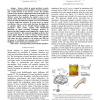50 search results - page 8 / 10 » Who Should Access Electronic Patient Records |
IHM
2003
ACM
14 years 21 days ago
2003
ACM
Despite the ubiquity of computers and on-line documents, paper persists. As physical objects, paper documents are easy to use, flexible, portable and are difficult to replace. Eve...
ICRA
2005
IEEE
14 years 1 months ago
2005
IEEE
– Intense activity in neural prosthetic research has recently demonstrated the possibility of robotic interfaces that respond directly to the nervous system. The question remains...
AIME
1997
Springer
13 years 11 months ago
1997
Springer
: Clinical guidelines reuse existing clinical procedural knowledge while leaving room for flexibility by the care provider applying that knowledge. Guidelines can be viewed as gene...
MIE
2008
13 years 8 months ago
2008
The current Swedish regulations for medical alerts in health records were designed for paper records. Suggestions for computerized systems are now being investigated. A proposed mo...
HICSS
2002
IEEE
14 years 12 days ago
2002
IEEE
We describe an approach to healthcare coordination using object life cycles (OLCs) [1]. By consulting the OLC of a given patient object instance, the legal methods to apply to tha...

